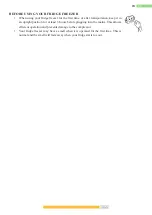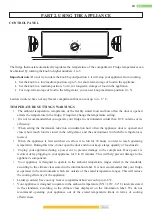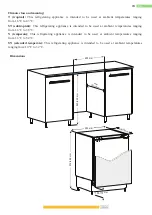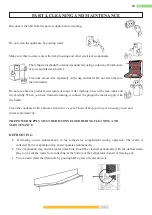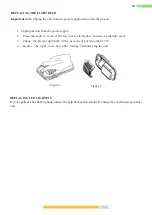
EN
27
•
To reduce humidity and avoid the consequent formation of frost, always store liquids in sealed
containers in the refrigerator. Frost tends to concentrate in the coldest parts of the evaporating liquid and,
in time, your appliance will require more frequent defrosting.
•
Never place warm food in the refrigerator. Warm food should be allowed to cool at room temperature
and should be arranged to ensure adequate air circulation in the refrigerator compartment.
•
Make sure no items are in direct contact with the rear wall of the appliance as frost will develop and
packaging will stick to it. Do not open the refrigerator door frequently.
•
Store loose fruit and vegetable items in the crisper containers.
•
Store loose fruit and vegetables in the crisper.
•
Storing fruit and vegetables separately helps prevent ethylene-sensitive vegetables (green leaves,
broccoli, carrot, etc.) being affected by ethylene-releaser fruits (banana, peach, apricot, fig etc.).
•
Do not put wet vegetables into the refrigerator.
•
Storage time for all food products depends on the initial quality of the food and an uninterrupted
refrigeration cycle before refrigerator storage.
•
To avoid cross-contamination do not store meat products with fruit and vegetables. Water leaking from
meat may contaminate other products in the refrigerator. You should package meat products and clean
any leakages on the shelves.
•
Do not put food in front of the air flow passage.
•
Consume packaged foods before the recommended expiry date.
•
For normal working conditions, it will be sufficient to adjust the temperature setting of your refrigerator
to +4 °C.
•
The temperature of the fridge compartment should be in the range of 0-8 °C, fresh foods below 0 °C are
iced and rotted, bacterial load increases above 8 °C, and spoils.
•
Do not put hot food in the refrigerator immediately, wait for the temperature to pass outside. Hot foods
increase the degree of your refrigerator and cause food poisoning and unnecessary spoiling of the food.
•
Meat, fish, etc. should be store in the chiller compartment of the food, and the vegetable compartment is
preferred for vegetables. (if available)
•
To prevent cross contamination, meat products and fruit vegetables are not stored together.
•
Foods should be placed in the refrigerator in closed containers or covered to prevent moisture and odors.
PART 3. FOOD STORAGE
FOOD
MAXIMUM STORING
TIME
WHERE TO PLACE IN THE
FRIDGE DEPARTMENT
Vegetables and fruits
1
week
Vegetable
bin
Meat and fish
2
-
3
Days
Wrapped in plastic foil or bags or in a
meat container (on the glass shelf)
Fresh cheese
3
-
4
Days
In
special
door
shelf
Butter and margarine
1
week
In
special
door
shelf
Bottled products
milk and yoghurt
Until the expiry date
recommended by the producer
In
special
door
shelf
Eggs
1
month
In
the
egg
shelf
Cooked food
—
All
shelves
Summary of Contents for KBC 08122.1
Page 1: ...INSTRUKCJA UŻYTKOWNIKA CHŁODZIARKI DO ZABUDOWY KBC 08122 1 www kernau com ...
Page 2: ......
Page 10: ...600 mm min 550 mm 820 890 mm 595 mm 548 mm 812 882 mm 170 mm 100 Wymiary PL 10 ...
Page 18: ...INSTRUCTION BOOKLET BUILD IN FRIDGE KBC 08122 1 www kernau com ...
Page 34: ...NVOD K OBSLUZE VESTAVĚNÝ CHLADIČ KBC 08122 1 www kernau com ...
Page 40: ...41 600 mm min 550 mm 820 890 mm 595 mm 548 mm 812 882 mm 170 mm 100 Rozměry 48 50 CZ 40 ...
Page 49: ...БРОШУРА ПО ВИКОРИСТАННЮ ВБУДОВАНИЙ ОХОЛОДЖУВАЧ KBC 08122 1 www kernau com ...
Page 50: ......
Page 58: ...UA 58 600 mm min 550 mm 820 890 mm 595 mm 548 mm 812 882 mm 170 mm 100 Розміри ...
Page 66: ...www kernau com ...












